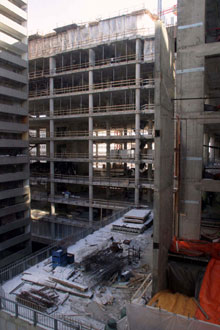Artists keen to move out of VA into their new facilities

What promises to be a sunny atrium in the visual arts part of the new Integrated Complex, as s een from the GM building.
The new Integrated Complex going up on Ste. Catherine St. can’t be finished a moment too soon, according to Dean of Fine Arts Chris Jackson.
“My expectation is that we’ll have classes there in September 2005, and facilities will have been installed during the preceding months,” he said in an interview with the faculty’s point man on the project, Professor John Locke.
“We don’t have close to the amount of space we need, but every unit that moves there will find it has more space — and it will be good to get out of this building.” The current VA Building on René Lévesque Blvd has notoriously poor ventilation for working artists.
The new facility will be on the Mackay St. side of the massive structure now going up, and will have 11 storeys to the engineering and computer science side’s 17. It will house teaching space as well as offices, and some of the most advanced research facilities anywhere on the continent.
One thing that pleases Jackson and Locke is that there are no interior walls between the two sections of the structure. At first glance strangely matched, the engineers and the artists are just beginning to explore synergies, and finding that they have a lot in common, especially in this digital age.
“The physical closeness means a lot,“ Jackson said. “There is more and more interaction, including a number of student projects, and the work is very interesting,
“There’s all kinds of potential, such as mechanical engineering working with design art. As for the joint digital image and sound program that brings computer and fine arts together, I don’t know any schools in Canada that are doing this, and now, with the proximity in terms of space, the timing couldn’t be better.”
CFI grants have driven the construction of this new building, including several to the two Faculties and a grant that gave rise to Hexagram, the inter-university digital arts research group.
Hexagram will have space in the building in the form of a below-ground two-storey black box for multimedia experimentation, and the two top floors. Many Concordia faculty members and students are involved in Hexagram projects, and we’ll tell you more in a future issue of CTR.
A lot of work went into the allocation of space. On the ground floor, the building will have two 100-seat amphitheatres, to be used primarily by the Art History Department. The dean’s office and student affairs will be on the second floor, and offices will be distributed throughout the building.
Information technology will be organized as discipline-specific satellites centralized on the fourth floor under the supervision of Judith Cézar.
Locke is especially pleased with the facilities for students and staff, including atrium spaces, outdoor terraces and lounges. “We will have some small spaces that solve longstanding problems, such as two offices for graduate students associated with the Faculty whose programs are administered by the School of Graduate Studies.”
At street level, there will be commercial tenants, but there will also be gallery space and a small sculpture court.
While some leased space can at last be vacated, including the old Bourget building on Mountain St. and the studio space on Overdale Ave., this construction will not end the Faculty’s space concerns by any means, Jackson said.
Problematic as it is, the VA Building will continue to house many activities, at least for the time being. This includes painting and drawing, ceramics, art therapy, art education, part of the sculpture unit and some screening space for the School of Cinema. The performing arts, based on the Loyola Campus, are eagerly awaiting a new facility.
However, the construction project represents a quantum leap in facilities for the university, Jackson said. From that monolith of the 1960s, the Henry F. Hall Building, to the J.W. McConnell library complex, opened in 1992, Concordia’s new buildings have been primarily conventional classroom space.
“Engineering and the visual arts have both grown immensely in their size and the complexity of their needs,” Jackson said. “The new building will be exciting, and it’s moving right along.”